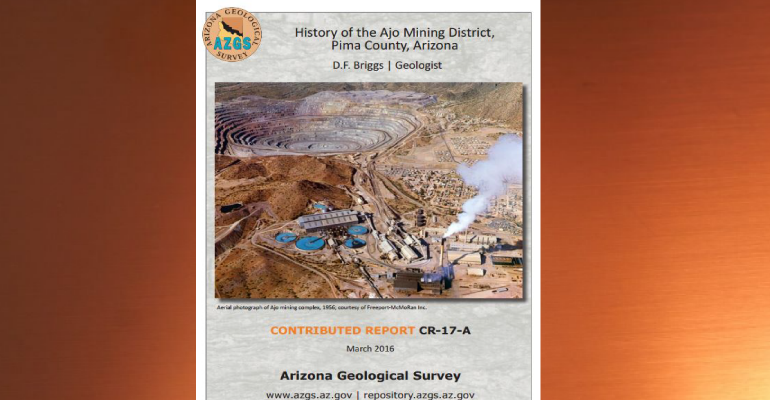
Geologist and occasional ADI contributor David Briggs has written another interesting paper on the history of mining in Arizona. This 18-page paper, History of the Ajo Mining District, Pima County, Arizona, was just published by the Arizona Geological Survey and is available as a free download: http://repository.azgs.az.gov/uri_gin/azgs/dlio/1710
I was particularly interested in the Ajo paper because as a geologist, I conducted exploration at the mine and in the district. Although the mine is now inactive, there is remaining mineralization that can be mined given the right economic conditions. The Ajo orebody is particularly interesting to geologists because paleomagnetic and geologic evidence indicates that the Ajo ore deposit has been tilted to the south a total of approximately 120 degrees in two separate tectonic events. (Source) There is also speculation that a detached piece of the original orebody lies hidden nearby.
Briggs begins his story as follows: “The hostile environment of southwestern Arizona’s low desert presented many challenges to those who sought to discover and exploit the mineral wealth of the region. Ajo’s remote location combined with hot summer days and scarce water created a number of obstacles that needed to be overcome. Despite these impediments, the district’s wealth was mined by Native Americans long before the arrival of first Spanish explorers, who recognized its potential soon after establishing outposts in this region.”
The Ajo area has a long history. Prior to the arrival of the first Spanish explorers in the 1530’s, the native Tohono O’odham Indians and their ancestors mined hematite, an iron oxide, which they used as body paint. Establishment of Spanish missions in Southern Arizona provided bases from which prospectors combed the country.
With the signing of the Treaty of Guadalupe Hidalgo at the end of the Mexican American War on February 2, 1848, and the subsequent Gadsden Purchase in June 1854, many prospectors tried their luck at Ajo.
Briggs provides great detail as he recounts the many lives of mining ventures in Ajo. Following is a very brief sketch of major events.
The first formal mining began in 1855 and a wagon road was constructed to the railroad at Gila Bend. Ore was also sent by wagon to San Diego and shipped to Swansea, Wales for smelting. High transportation costs eventually made the venture uneconomic.
Briggs recounts the era between 1898 and 1908 when the Ajo deposit saw many promotions and fraudulent mining schemes.
In 1911, the Calumet and Arizona Mining Company, which was operating mines in Bisbee, became interested in the Ajo properties and acquired the New Cornelia Copper Company which owned Ajo at the time. Calumet began an extensive drilling program which confirmed the presence of a large sulfide body of mineralization. They began open pit mining in 1915.
In 1931, Phelps Dodge merged with Calumet and Arizona Mining Company and continued to operate the mine which they did until 1985 when a combination of low copper prices and stricter regulations for smelter air quality caused the company to close the mine.
The Ajo property is now owned by Freeport-McMoRan, Inc. through its merger with Phelps Dodge. According to Briggs, “Freeport continues to periodically assess the economic feasibility of returning the Ajo project to production. As of December 31, 2015, this project is estimated to contain a sulfide resource of 482 million short tons, averaging 0.40% copper, 0.010% molybdenum, 0.002 oz. of gold/ton and 0.023 oz. of silver/ton.”
Other papers by David Briggs, published by the Arizona Geological Survey:
- History of the Warren (Bisbee) Mining District
- History of the San Manuel-Kalamazoo Mine, Pinal County, Arizona
- Recovery of Copper by Solution Mining Techniques
- Superior, Arizona – An Old Mining Camp with Many Lives
- History of the Copper Mountain (Morenci) Mining District
- History of Helvetia-Rosemont Mining District, Pima County, Arizona
Note to readers:
- Index with links to all my ADI articles: http://wp.me/P3SUNp-1pi
- My comprehensive 28-page essay on climate change: http://wp.me/P3SUNp-1bq
- A shorter ADI version is at https://arizonadailyindependent.com/2013/08/01/climate-change-in-perspective/
